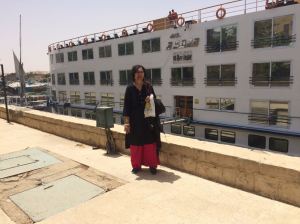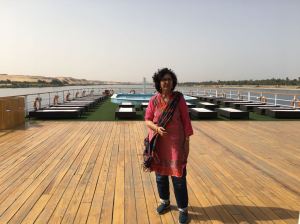
The one and half hour flight from Cairo to Aswan was fairly pleasant in the vintage aircraft; the tour operator had insisted that I travel in business class as he had noticed that the difference in price from the economy class was manageable. Aswan airport reminded me of our own one at Bakshi Ka Talab at Lucknow; rudimentary, rustic having bare minimum basic necessities. The roads and the pavements outside the building had the same look and were in similar condition
As we came out of the airport, I was in for two shocks; as she came out of the building my wife stumbled and fell on the uneven sidewalk injuring her shoulder and knee. She bore the pain like a ‘steel’ lady throughout the tour which included the trip to Greece and Turkey. The physiotherapist on the cruise boat attended to her diagnosing it as muscular ailment, later on arrival at Boston the x ray displayed a fracture in her shoulder bone and knee bruises! For nearly three weeks of our tour she had held on with the shoulder and knee pain while travelling to distant places under various conditions and contingencies, smiling out her misery.
“I am your guide and my name is Emily“ a young pretty face smiled with an extended arm.
For a moment it shook me, for in my weird imagination I could have never placed a lady guide in a country having 98% Muslims and with the Muslim Brotherhood looming large and pressing for the enforcement of sharia laws. We shook hands and for the next two days she guided the two of us taking us to the dam, temples, shops and the islands. A post graduate in archeology from Cairo University and a certified guide, she spoke fluent english, in an accent understood clearly by us. Her narration of each aspect of the historical places and monuments was lucid and informative. In a nutshell we enjoyed her company as much as she did ours.
Our tour operator had assured us that our boat had a reputation as a splendid Nile cruise ship; he was right, we found our cabin spacious, well stocked and comfortable. Like most cruise liners this boat too was fairly large with multiple decks accommodating large number of living cabins and miscellaneous recreational facilities.
After depositing our luggage in our cabin we headed for the Aswan dam, which to a large extent has changed the lives of Egyptians by increasing the cultivable lands through irrigation and generating surplus electricity for the Nation. The Nasser lake did though flood the lower areas dislocating the towns and villages resettling thousands of men and women both in Egypt and Sudan. Fortunately UNESCO aided the country in relocating its historical monuments and temples to higher and safer grounds.
One such monument was the temple at Philae which was originally located near the expansive First Cataract of the Nile in Upper Egypt and was a vast complex. This temple complex was later dismantled and relocated including the unfinished Obelisk to nearby Agilkia Island part of the UNESCO Nubia Campaign project, protecting this and other complexes before the 1970 completion of the Aswan High Dam. To me it appeared to have been in its new location ever since since it had been built many ages ago.

![]()



The dining hall on the cruise boat was jam packed with diners as we entered it, the steward came forward and guided us to our table which remained marked exclusively for us for the rest of the journey of three nights and two days. Amidst loud clatter and cacophony the more strident and discordant voices were emanating from the tables occupied by the Chinese. To me it appeared that in the loud, nasal and exuberant conversation speakers were competing to be heard without realising that others from various nationalities too were listening. I kept marvelling if I would witness similar scenes in a cruise boat on the Yangtze river! The cuisine served to us was assorted and well prepared and catered to different and varying tastes.
We left the dining hall after our meal and headed for the cabin and hit the bed early. For most part of the night my thoughts were filled with past journeys undertaken in the past on the Nile river by the famous kings, queens and conquerors.
For 4,250 miles the Nile snakes through nine countries, from the Delta region of Lower Egypt all the way to Lake Victoria, the biggest of the African Great Lakes. The Blue Nile begins at Lake Tana, Ethiopia, and joins the White Nile south of Egypt in Khartoum, Sudan. Together, they make up the longest river in the world, the blue thread that binds Africa.
Like most in India worship the Ganges calling it ‘Ganga Maiya’ (mother ganges) and consider ‘gangajal’ (ganges water) as sacred, the common Egyptian blessing is: “May you always drink from the Nile.” The Nile River, for all its importance to the Ancient Egyptian, had no deity. It didn’t even have a name. Most simply called it “the river,” or “aur,” which means black. The closest thing to a god assigned to the Nile was Hapy, the God of the Inundation. Hapy had no temple. He was a fat, jubilant deity praised at the beginning of every flood cycle and mentioned only in passing the rest of the year. The river’s West bank, where the sun set, was the side of death. All Ancient Egyptian tombs and pyramids were constructed on the west side of the Nile.
Reverting to the famous who sailed on the river over the ages (could we too be counted for having performed the the journey on the Nile!), the list is long and appealing.
- The Pharaohs considered to be Egypt’s most successful kings, leaving a multitude of building projects;
- Alexander who was regarded as a liberator by the Egyptians.
- Caesar and Cleopatra spent several months sailing along the Nile, where Caesar observed how the Egyptian people worshipped Cleopatra as a pharaoh.
- Abraham, Jacob, Joseph, Job, Jacob’s 12 sons and their descendants—the Bible reveals that all these men lived in Egypt at some point in their lives, and played a crucial role in early Egyptian history.
- Moses who was adopted by an Egyptian princess, and later in life became the leader of the Israelites.
- Many more men and women engaged in wars, trade and commerce.


Next morning the boat sailed along the River till Komombo where it stopped for a few hours to enable us to see the amazing temple which was dedicated to 2 different Goddess. It continued sailing until Edfu temple. This remarkable temple was dedicated to God Horus , God of power and protection for the ancient Egyptian and is considered to be one of the most preserved temples in Egypt. The nearby Temple of Sobek is one half of a distinct double temple. The crocodile god is enshrined in much of the temple’s artwork, and in the 300 mummified crocodiles displayed in the temple’s Crocodile Museum, which we decided to skip.

As the sun came down we decided to plonk ourselves on the upper deck to enjoy the vision of it setting under the water on the distant horizon. A gathering of noisy Chinese occupied most of the tables and I decided to mix and socialise with them. Introducing myself and informing them that I am from India, I was rather perturbed to notice blank faces in response. From some distance behind me I heard a voice informing me in english that most of the Chinese did not understand english. At my request the english speaking chinese spoke in his language repeating my introductory sentence. To my surprise it made no difference, the blank looks all around remained.
“They do not know where India is. Not uncommon, as they are from interior China,” the english speaking Chinese told me.
For a moment, I felt disconsolate and puzzled; how come we consider enmity towards them when they do not even know that we exist! Wisdom quickly dawned on me, it is the politicians who force them and us to confront and become enemies!
The next day the boat halted at the West Bank of Luxor and after breakfast we visited the Valley of the Kings , which contains 64 royal tombs of the Egyptian pharaohs. Visitors are permitted to explore only 3 tombs and photography inside the tombs is prohibited. From here the bus ride took us to Queen Hatshepsut temple and Colossi statues of Memnon.
At night , the much trumpeted belly dancers performed in the banquet hall of the boat. Their performance did not appeal to me or my wife, who have witnessed better and more appealing dancers gyrating and twisting, however the Chinese crowd kept loudly cheering, whistling and thoroughly enjoying the show, when we left the hall early.
On the last day of the Cruise we explored the amazing temples of Karnak , a series of temples inside each other and the great Hypostyle Hall with it’s 134 gigantic columns whose original colours still exist . Finally tour of Luxor Temple was indeed revealing with it’s beautiful obelisk and inscription recorded on it’s walls.




The Nile river remains an integral part of Egyptian life, lore and commerce today and it is said by the Egyptians that, should a visitor once look upon the beauty of the Nile, the return of that visitor to Egypt is assured (a claim made, also, in antiquity).
We would certainly love to return!

Beautifully narrated travelogue,of one of the most historic places of biblical times.A must visit tour for all.
LikeLike
Thank you Zafar.
LikeLike
Very readable. Fluidly written but occasionally reveals the maturity of the writer when unnecessary socio-political comments are interspersed, but then the safarnama does state that it is “impressions, perceptions, and views”!
Travel tips are essential ingredients of a travelogue, as readers are looking for factors that could aid in their own future travels.
LikeLiked by 1 person
Many thanks Misbah. God bless you & the family
LikeLike
The attention to detail, minute observations made and that too in such a non judgmental, objective way only remind me of one of my favorite ways to describe writer, “An author in his book (writings) must be like God in the universe, present everywhere and visible nowhere.”- Falubert.
LikeLike
Many thanks Beti. Humbled & honored! God bless you & your family.
LikeLike
Regards for all your efforts that you have put in this. very interesting info .
LikeLike
I really enjoy examining on this website , it holds superb blog posts.
LikeLike
I reckon something truly interesting about your weblog so I saved to favorites.
LikeLike
I gotta favorite this website it seems extremely helpful extremely helpful
LikeLike
Muchas gracias. ?Como puedo iniciar sesion?
LikeLike